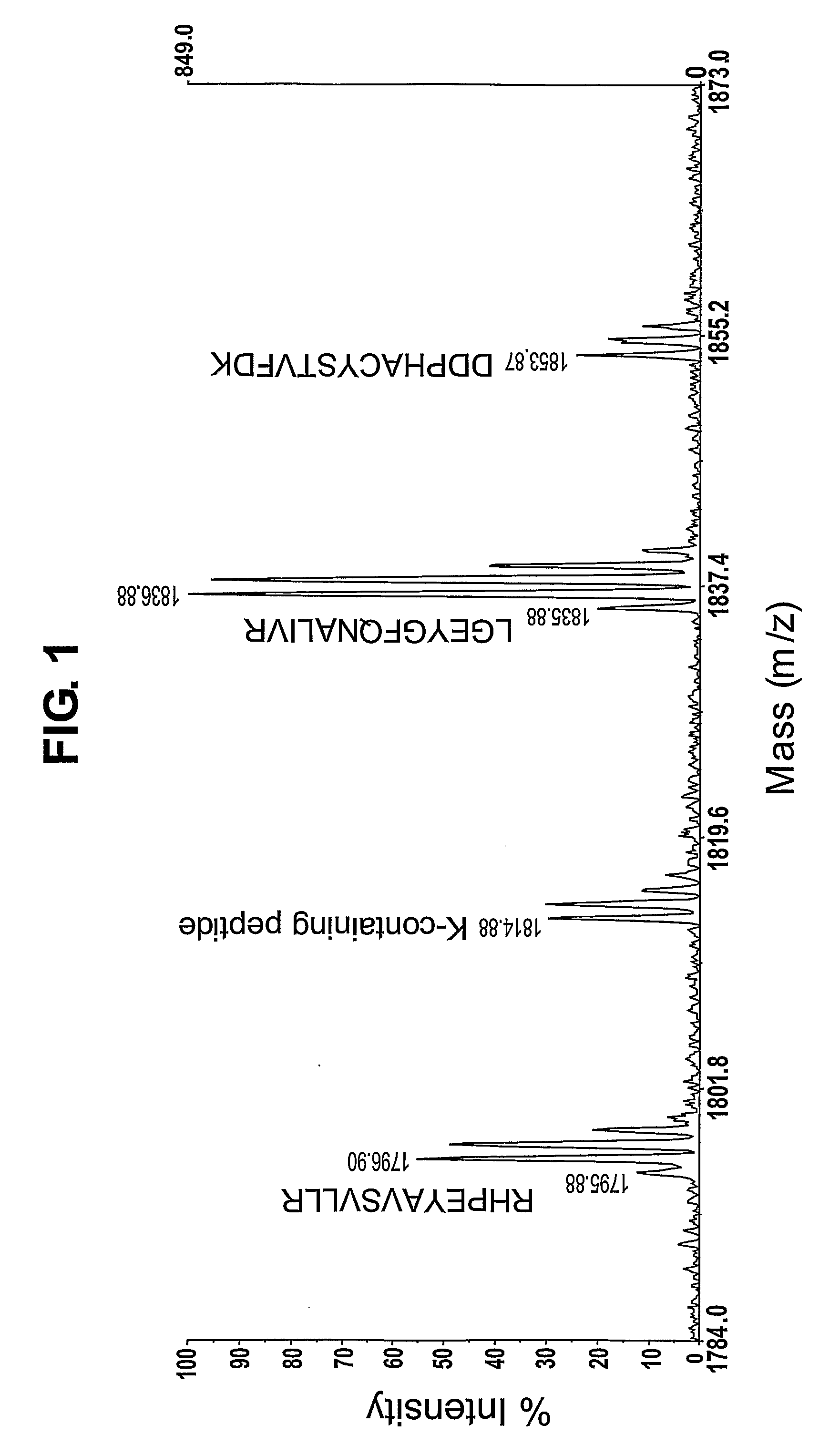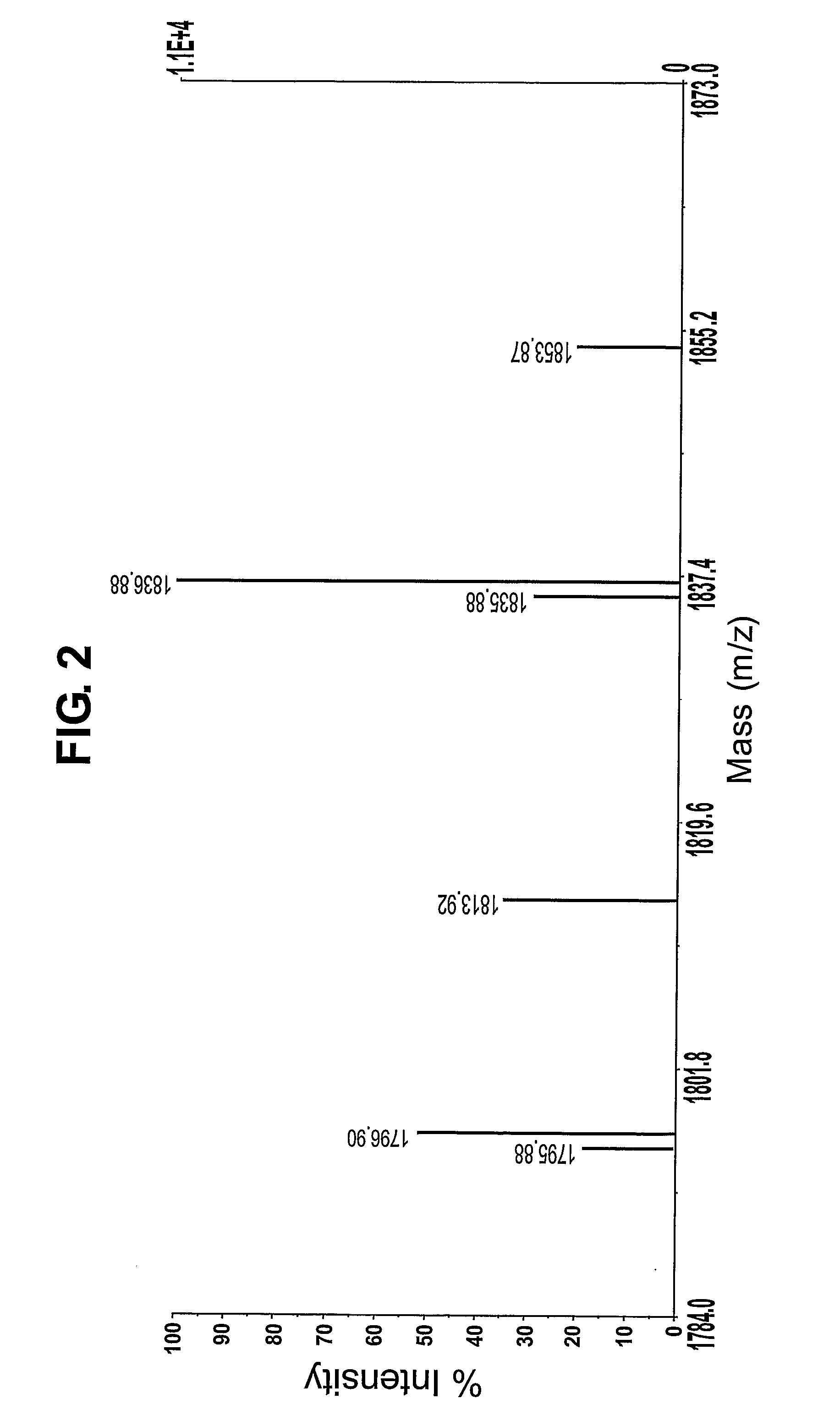Mass Spectrometry of Arginine-Containing Peptides
a mass spectrometry and arginine-containing peptide technology, applied in the field of mass spectrometry analysis of arginine-containing peptides, can solve the problems of reducing the efficiency of this method as a protein identification tool, difficult to distinguish proteins, and inability to unambiguously identify proteins, etc., to improve the certainty of search output, improve efficiency, and simplify the sequence space
- Summary
- Abstract
- Description
- Claims
- Application Information
AI Technical Summary
Benefits of technology
Problems solved by technology
Method used
Image
Examples
example 1
Comparison of Isotopic Distributions for Specific Peptide(s)
[0117]BSA was digested with trypsin and then derivatised with a dimethoxytrityl label of the invention. FIG. 1 shows a narrow portion of the mass spectrum generated by MALDI-TOF analysis of the digested protein. The characteristic peak pattern observed for the two peptides that contain arginine contrasts with the peak pattern observed for the two peptides that do not contain arginine residues. The peak pattern observed for the two peptides that do not contain arginine residues is the ‘traditional’ MALDI-TOF peak pattern for peptides.
[0118]FIG. 2 shows the mass spectrum of FIG. 1 following centroiding and deisotoping. FIG. 2 shows that, after deisotoping, derivatised peptides that contain an arginine residue are represented by a peak pattern comprising a first peak and a second peak separated by one average mass unit. In this example, the first peak is less abundant than the second peak. In contrast, derivatised peptides tha...
example 2
BSA Fragmentation and Mass Spectrometry
[0121]Bovine serum albumin (BSA) was digested with trypsin and analysed by MALDI-TOF mass spectrometry. The resulting spectrum is shown in FIG. 4. The experiment was repeated, but the peptide mixture was labelled with a dimethoxytrityl label after trypsin digestion. The spectrum in FIG. 5 shows the dramatic increase in visible ions due to the label. Four specific peptides have been highlighted in both spectra.
example 3
Improvement in Peptide Mass Fingerprinting
[0122]Three proteins (BSA, β-casein and ADH) were digested with trypsin and the resulting peptides analysed by MALDI-TOF mass spectrometry with or without derivatisation. The number of peptides identified for each protein is shown below. The theoretical total number of peptides that would be produced by trypsin digestion of each protein was calculated in silico and is shown in the second column of the table:
Total number ofNumber ofpeptides identifiedMASCOT search score*Proteintheoretical peptides+UnderivatisedDerivatisedUnderivatisedDerivatisedBSA14414 (10%) 41 (28%)132126β-casein274 (15%)13 (48%)no match123ADH607 (12%)18 (30%) 77111+The number of theoretical peptides for each protein was generated assuming one missed cleavage and disregarding di- and mono-amino acids generated.*Score is −10 * Log(P), where P is the probability that the observed match is a random event. Protein scores greater than 63 are significant (p
[0123]Derivatisation o...
PUM
| Property | Measurement | Unit |
|---|---|---|
| mass spectrometry | aaaaa | aaaaa |
| average mass | aaaaa | aaaaa |
| mass spectrum | aaaaa | aaaaa |
Abstract
Description
Claims
Application Information
 Login to View More
Login to View More - R&D
- Intellectual Property
- Life Sciences
- Materials
- Tech Scout
- Unparalleled Data Quality
- Higher Quality Content
- 60% Fewer Hallucinations
Browse by: Latest US Patents, China's latest patents, Technical Efficacy Thesaurus, Application Domain, Technology Topic, Popular Technical Reports.
© 2025 PatSnap. All rights reserved.Legal|Privacy policy|Modern Slavery Act Transparency Statement|Sitemap|About US| Contact US: help@patsnap.com



